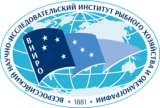База данных: Электронная библиотека
Страница 1, Результатов: 2
Отмеченные записи: 0
1.

Подробнее
Б 16
Бажин/Bazhin, А.Г./A.G.
К пространственной структуре поселений беринговоморского гребешка Chlamys behringiana (Bivalvia, Pectinidae) в западной части Берингова моря = On spatial structure of the Bering Sea scallop Chlamys behringiana (Bivalvia, Pectinidae) populations in the Western Bering Sea / Бажин/Bazhin, А.Г./A.G., Буяновский/Buyanovsky, А.И./A.I. // Прибрежные гидробиологические исследования: Труды ВНИРО.-М.: Изд-во ВНИРО, 2005.-Т. 144. - С. 110-115./Coastal hydrobiological investigations: VNIRO Proceedings.-M.: VNIRO Publishing, 2005.-V. 144.-P. 110-115. - 2005
~РУБ Article
Рубрики: Гребешок беринговоморский/Chlamys behringiana
Берингово море/Bering Sea
Гидродинамика/Hydrodynamics
Грунт/Sediment
Распределение/Distribution
Численность/Population
Аннотация: Рассматриваются данные распределения гребешка Chlamys behringiana в юго-западной части Берингова моря. Первое скопление было найдено к востоку от острова Карагинский (59 гр.N, 166 гр. E), второе - к югу от мыса Олюторский (60 гр. N, 171 гр. E). Наибольшие уловы (более 500 экз. за 30 минут драгирования) были отмечены на глубинах 110-130 м. Крупные особи гребешков занимают более мелкие глубины, чем мелкие. Образование скоплений определяется как характером гидродинамического режима, так и распределением грунтов (преимущественно гравия)./Data on distribution of the scallop Chlamys behringiana in the south-west Bering Sea are given. The first aggregation was found to the east of the Karaginskiy Island (59 degrees N, 166 degrees E), and the second one to the south of the Olyutorsky Cape (60 degrees N, 171 degrees E). The most numerous catches (more than 500 individuals per 30 minutes of dragging) were taken at depths 110-130 m. Large specimens were found within a narrower depth range than smaller ones. Aggregations formation may be caused by both hydrodynamic circulation and distribution pattern of sediments (presumably gravel).
Доп.точки доступа:
Буяновский/Buyanovsky, А.И./A.I.
Б 16
Бажин/Bazhin, А.Г./A.G.
К пространственной структуре поселений беринговоморского гребешка Chlamys behringiana (Bivalvia, Pectinidae) в западной части Берингова моря = On spatial structure of the Bering Sea scallop Chlamys behringiana (Bivalvia, Pectinidae) populations in the Western Bering Sea / Бажин/Bazhin, А.Г./A.G., Буяновский/Buyanovsky, А.И./A.I. // Прибрежные гидробиологические исследования: Труды ВНИРО.-М.: Изд-во ВНИРО, 2005.-Т. 144. - С. 110-115./Coastal hydrobiological investigations: VNIRO Proceedings.-M.: VNIRO Publishing, 2005.-V. 144.-P. 110-115. - 2005
Рубрики: Гребешок беринговоморский/Chlamys behringiana
Берингово море/Bering Sea
Гидродинамика/Hydrodynamics
Грунт/Sediment
Распределение/Distribution
Численность/Population
Аннотация: Рассматриваются данные распределения гребешка Chlamys behringiana в юго-западной части Берингова моря. Первое скопление было найдено к востоку от острова Карагинский (59 гр.N, 166 гр. E), второе - к югу от мыса Олюторский (60 гр. N, 171 гр. E). Наибольшие уловы (более 500 экз. за 30 минут драгирования) были отмечены на глубинах 110-130 м. Крупные особи гребешков занимают более мелкие глубины, чем мелкие. Образование скоплений определяется как характером гидродинамического режима, так и распределением грунтов (преимущественно гравия)./Data on distribution of the scallop Chlamys behringiana in the south-west Bering Sea are given. The first aggregation was found to the east of the Karaginskiy Island (59 degrees N, 166 degrees E), and the second one to the south of the Olyutorsky Cape (60 degrees N, 171 degrees E). The most numerous catches (more than 500 individuals per 30 minutes of dragging) were taken at depths 110-130 m. Large specimens were found within a narrower depth range than smaller ones. Aggregations formation may be caused by both hydrodynamic circulation and distribution pattern of sediments (presumably gravel).
Доп.точки доступа:
Буяновский/Buyanovsky, А.И./A.I.
2.
Подробнее
Т 35
Терентьев/Terentyev, А.С./A.S.
Динамика запаса мидии в Керченском предпроливье Черного моря = Changes of mussel stock in the Black Sea shelf area adjacent to the Kerch strait / Терентьев/Terentyev, А.С./A.S. // Морские промысловые беспозвоночные и водоросли: биология и промысел. К 70-летию со дня рождения Бориса Георгиевича Иванова: Труды ВНИРО / Отв. ред. В.И. Соколов.- М.: Изд-во ВНИРО, 2007.- Т. 147.- С. 335-349./Marine commercial invertebrates and algae (biology and fishery). To 70-th anniversary of B.G. Ivanov: VNIRO Proceedings / Editor-in-Chief V.I. Sokolov. - M.: VNIRO Publishing, 2007. - V. 147. - P. 335-349. - 2007
~РУБ Article
Рубрики: Керченский пролив/Kerch strait
Биомасса/Biomass
Мидии/Mussels
Запасы/Stocks
Черное море/Black Sea
Грунт/Sediment
Аннотация: Мидия встречается повсеместно на мелководье Черного моря, прилегающем к Керченскому проливу, от уреза воды до глубин порядка 45 м. Наибольшие скопления мидий обнаружены в центральной и западной частях района, прилегающего к Керченскому проливу, на глубинах от 25 до 42 м. С 1986 г. по 1990 г. встречаемость мидии на исследованной акватории снизилась с 64-82% до 21-35%, а ее численность уменьшилась с 69+-13 экз/м2 до 16,4+-2,6 экз/м2 (в 3-5 раз). Запас мидии с 1986 по 1990 г. снизился с 437+-21 тыс. т до 217+-21 тыс. т (с 223+-42 млрд. экз. до 56,0+-8,8 млрд. экз.). Снижение численности мидии сопровождалось сильным дроблением некогда сплошного ее поселения на исследованной акватории./Long-term changes in distribution, abundance and biomass of common mussel Mytilus galloprovincialis (lamarck, 1819) were studied on the Black Sea shelf adjacent to the Kerch Strait by means of benthic survey conducted betwee 1986 and 1990. The mussel occurred throughout the survey area from the shoreline down to 42 m. Between 1986 and 1990 the occurrence frequency of mussels in the studied area reduced 2-3 times: from 64-82% to 21-35%, and its abundance reduced 3-5 times: from 69+-13 individuals/m2 to 16.4+-2.6individuals/m2. The stock of mussel declined 3-5 times: from 223+-42 to 56.0+-8.8 billion individuals (from 437+-21 to 217+-21 thousand tons). Entire mussel settlement on the shelf adjacent to the Kerch Strait split into a number of small local settlements.
Т 35
Терентьев/Terentyev, А.С./A.S.
Динамика запаса мидии в Керченском предпроливье Черного моря = Changes of mussel stock in the Black Sea shelf area adjacent to the Kerch strait / Терентьев/Terentyev, А.С./A.S. // Морские промысловые беспозвоночные и водоросли: биология и промысел. К 70-летию со дня рождения Бориса Георгиевича Иванова: Труды ВНИРО / Отв. ред. В.И. Соколов.- М.: Изд-во ВНИРО, 2007.- Т. 147.- С. 335-349./Marine commercial invertebrates and algae (biology and fishery). To 70-th anniversary of B.G. Ivanov: VNIRO Proceedings / Editor-in-Chief V.I. Sokolov. - M.: VNIRO Publishing, 2007. - V. 147. - P. 335-349. - 2007
Рубрики: Керченский пролив/Kerch strait
Биомасса/Biomass
Мидии/Mussels
Запасы/Stocks
Черное море/Black Sea
Грунт/Sediment
Аннотация: Мидия встречается повсеместно на мелководье Черного моря, прилегающем к Керченскому проливу, от уреза воды до глубин порядка 45 м. Наибольшие скопления мидий обнаружены в центральной и западной частях района, прилегающего к Керченскому проливу, на глубинах от 25 до 42 м. С 1986 г. по 1990 г. встречаемость мидии на исследованной акватории снизилась с 64-82% до 21-35%, а ее численность уменьшилась с 69+-13 экз/м2 до 16,4+-2,6 экз/м2 (в 3-5 раз). Запас мидии с 1986 по 1990 г. снизился с 437+-21 тыс. т до 217+-21 тыс. т (с 223+-42 млрд. экз. до 56,0+-8,8 млрд. экз.). Снижение численности мидии сопровождалось сильным дроблением некогда сплошного ее поселения на исследованной акватории./Long-term changes in distribution, abundance and biomass of common mussel Mytilus galloprovincialis (lamarck, 1819) were studied on the Black Sea shelf adjacent to the Kerch Strait by means of benthic survey conducted betwee 1986 and 1990. The mussel occurred throughout the survey area from the shoreline down to 42 m. Between 1986 and 1990 the occurrence frequency of mussels in the studied area reduced 2-3 times: from 64-82% to 21-35%, and its abundance reduced 3-5 times: from 69+-13 individuals/m2 to 16.4+-2.6individuals/m2. The stock of mussel declined 3-5 times: from 223+-42 to 56.0+-8.8 billion individuals (from 437+-21 to 217+-21 thousand tons). Entire mussel settlement on the shelf adjacent to the Kerch Strait split into a number of small local settlements.
Страница 1, Результатов: 2
